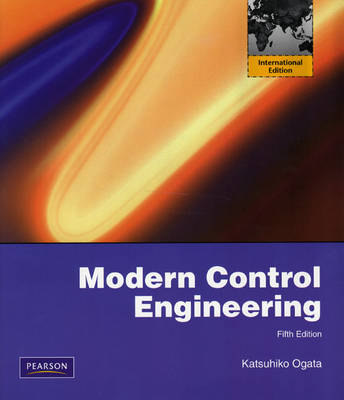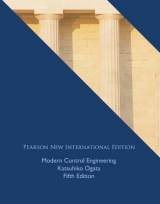
Modern Control Engineering
Pearson (Verlag)
978-0-13-713337-6 (ISBN)
- Titel erscheint in neuer Auflage
- Artikel merken
A comprehensive, senior-level textbook for control engineering.
Ogata’s Modern Control Engineering, 5/e, offers the comprehensive coverage of continuous-time control systems that all senior students must have, including frequency response approach, root-locus approach, and state-space approach to analysis and design of control systems. The text provides a gradual development of control theory, shows how to solve all computational problems with MATLAB, and avoids highly mathematical arguments. A wealth of examples and worked problems are featured throughout the text.
The new edition includes improved coverage of Root-Locus Analysis (Chapter 6) and Frequency-Response Analysis (Chapter 8). The author has also updated and revised many of the worked examples and end-of-chapter problems. This text is ideal for control systems engineers.
Dr. Katsuhiko Ogata graduated from the University of Tokyo (BS), earned an MS degree from the University of Illinois, and his Ph.D from the University of California, Berkeley. He is Professor Emeritus at the University of Minnesota.
Contents
Preface
Chapter 1 Introduction to Control Systems
1—1 Introduction
1—2 Examples of Control Systems
1—3 Closed-Loop Control versus Open-Loop Control
1—4 Outline of the Book
Chapter 2 Mathematical Modeling of Control Systems
2—1 Introduction
2—2 Transfer Function and impulse Response Function
2—3 Atomatic Control Systems
2—4 Modeling in state space
2—5 State-Space Representation of Scalar Differential Equation System
2—6 Transformation of Mathematical models with MATLAB
2—7 Linearization of Nonlinear Mathematical Models
Example Problems and Solutions Problems
Chapter 3 Mathematical Modeling of Mechanical Systems and Electrical Systems
3—1 Introduction
3—2 Mathematical Modeling of Mechanical Systems
3—3 Mathematical Modeling of Electrical Systems
Example Problems and Solutions Problems
Chapter 4 Mathematical Modeling of Fluid Systems
and Thermal Systems
4—1 Introduction 152
4—2 Liquid-Level Systems
4—3 Pneumatic Systems
4—4 Hydraulic Systems
4—5 Thermal Systems
Example Problems and Solutions Problems
Chapter 5 Transient and Steady-State Response Analyses
5—1 Introduction
5—2 First-Order Systems
5—3 Second-Order Systems
5—4 Higher Order Systems
5—5 Transient-Response Analysis with MATLAB
5—6 Routh’s Stability Criterion
5—7 Effects of Integral and Derivative Control Actions on System
Performance
5—8 Steady-State Errors in Unity-Feedback Control Systems
Example Problems and Solutions Problems
Chapter 6 Control Systems Analysis and design by the Root-Locus Method
6—1 Introduction
6—2 Root-Locus Plots
6—3 plotting Root Loci with MATLAB
6—4 Root-Locus Plots of Positive Feedback Systems
6—5 Root-Locus Approach to control Systems Design
6—6 Lead Compensation
6—7 Lag Compensation
6-8 Lag-Lead Compensation
Example Problems and Solutions Problems
Chapter 7 Control Systems Analysis and Design by the Frequency Response Method
7—1 Introduction
7—2 Bode Digrams
7—3 Polar Plots
7—4 Log-Magnitude-versus-Phase plots
7—5 Nyquist Stability Criterion
7—6 Stability Analysis
7-7 Relative Stability Analysis
7-8 Closed-Loop Frequency Response of Unity-feedback Systems
7-9 Experimental Determination of Transfer functions
7-10 Control Systems design by Frequency Response Approach
7-11 Lead Compensation
7-12 Lag Compensation
7-13 Lag-Lead Compensation
Example Problems and Solutions Problems
Chapter 8 PID Controllers and Modified PID Controllers
8—1 Introduction
8—2 Ziegler- Nichols Rules for tuning PID controllers
8—3 Design of PID Controllers with Frequency Response Approach
8—4 Design of PID Controllers with Computational Optimization Approach
8—5 Modification of PID Control Schemes
8—6 Two-Degrees-of-freedom PID Control Schemes
8—7 Zero Placement Approach to Improve Response
Example Problems and Solutions Problems
Chapter 9 Control Systems Analysis in State Space
9—1 Introduction
9—2 State-space Representations of Transfer-Function Systems
9—3 Transformation of System Models with MATLAB
9—4 Solving the Time-Invariant State Equation
9—5 Some Useful Results in vector-Matrix Analysis
9-6 Controllability
9-7 Observability
Example Problems and Solutions Problems
Chapter 10 Control Systems Design of in State Space
10—1 Introduction
10—2 Pole Placement
10—3 Solving Pole-Placement Problems with MATLAB
10—4 Design of Servo Systems
10—5 State Observers
10—6 Design of Regulator Systems with Observers
10—7 Design of Control Systems with Observers
10—8 Quadratic Optimal Regulator Systems
10-9 Robust Control Solutions
Example Problems and Solutions Problems
Appendix A
Appendix B
Appendix C
References
Index
| Sprache | englisch |
|---|---|
| Maße | 205 x 235 mm |
| Gewicht | 1468 g |
| Themenwelt | Technik ► Elektrotechnik / Energietechnik |
| ISBN-10 | 0-13-713337-5 / 0137133375 |
| ISBN-13 | 978-0-13-713337-6 / 9780137133376 |
| Zustand | Neuware |
| Haben Sie eine Frage zum Produkt? |
aus dem Bereich



